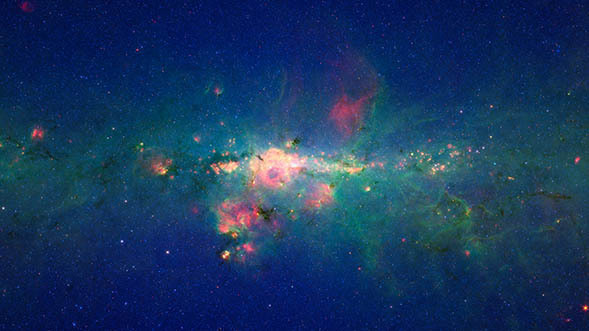
Cryogenic Mission:
On August 25, 2003 NASA's Spitzer Space Telescope (then called the Space Infrared Telescope Facility, or SIRTF) launched aboard a Delta 7920H rocket from Cape Canaveral Air Force Station in Florida.
In December 2003, four months after its launch, NASA formally gave the Spitzer Space Telescope its new name, finally retiring the old SIRTF acronym.
Spitzer carried three cryogenically cooled instruments. In a new and innovative launch configuration, the telescope was launched warm and passively cooled during the first 3 months of the mission. The instruments were cooled directly with liquid helium. The liquid helium also vented into the telescope, passively cooling the entire system.
The mission cryogenic lifetime was designed for a minimum of 2.5 years but lasted more than two times longer, with the cryogen being depleted after 5.5 years on May 15, 2009. The cryogenic instruments were:
- Infrared Array Camera (IRAC) - simultaneous imaging at 3.6, 4.5, 5.6, and 8.0 microns
- Infrared Spectrograph (IRS) – high- and low-resolution spectroscopy at 5 – 40 microns plus 16 micron imaging
- Multiband Imaging Photometer for Spitzer (MIPS) – imaging at 24, 70, and 160 microns plus low resolution spectroscopy at 55 – 95 microns
Warm Mission:
After the depletion of the cryogen on May 15, 2009, Spitzer began a new ‘warm’ mission, at 28K, in July 2009. The IRAC 3.6 and 4.5 micron cameras still worked at peak performance. This is the near- to mid-infrared portion of the spectrum. Astronomers used IRAC to study everything from comets and asteroids in our solar system, planets orbiting other stars, to the most distant galaxies in the Universe.
Each IRAC detector imaged a 5 x 5 arcminute area of the sky. IRAC could quickly and efficiently map large areas of the sky and conversely could stare at a single point on the sky for tens of hours with the only interruptions caused by the necessity to point at the earth every 24 – 48 hours to downlink the observations.
In the warm mode of operations, Spitzer continued to operate until the observatory was decommissioned on January 30, 2020.



